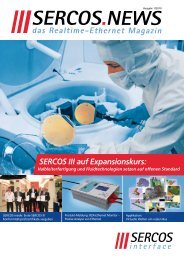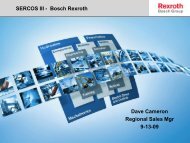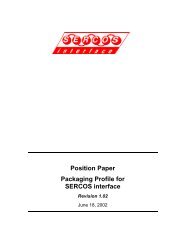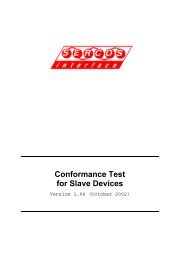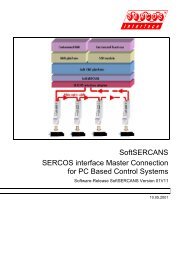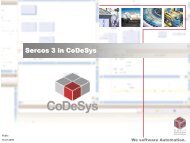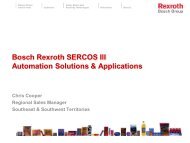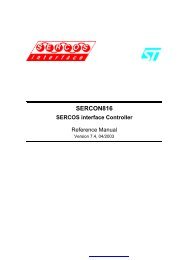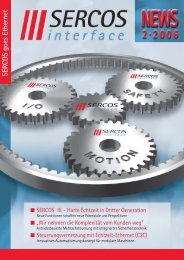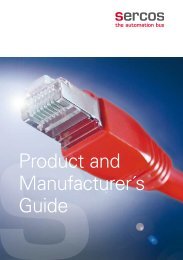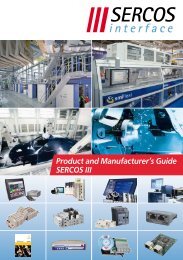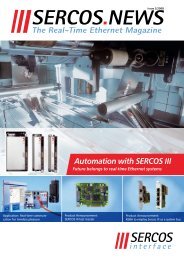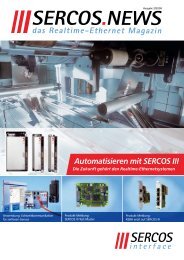SERCOS News - Issue 1 - 2008
SERCOS News - Issue 1 - 2008
SERCOS News - Issue 1 - 2008
Create successful ePaper yourself
Turn your PDF publications into a flip-book with our unique Google optimized e-Paper software.
The Real-Time Ethernet Magazine<br />
Product-<strong>News</strong> 15<br />
Quick-Info 1-0812 <br />
Digital and Analog I/Os on <strong>SERCOS</strong> III<br />
Inline Block I/O on <strong>SERCOS</strong> III<br />
www.phoenixcontact.com<br />
The new <strong>SERCOS</strong> III digital and analog module from Phoenix<br />
Contact’s compact Inline Block IO product line lets you quickly and<br />
easily connect sensors and actuators to the <strong>SERCOS</strong> III network.<br />
The digital module features 16 digital inputs and 16 combined<br />
digital inputs and outputs. The combined input/output channels<br />
can function without internal parameterization by simply connecting<br />
a sensor or actuator. The low delay times of the inputs and<br />
outputs (ton typ. 50 µs, toff typ. 150 µs) allows the use of control<br />
programs such as a motion control application.<br />
The analog module has four inputs and two outputs that can be<br />
configured individually and independently of each other. The four<br />
differential inputs can receive analog current signals of 0 mA to 20 mA,<br />
4 mA to 20 mA and ±20 mA or voltage signals of 0 V to 10 V, ±10 V,<br />
0 V to 5 V and ±5 V and also measure the temperature by means<br />
of a resistance thermometer (RTFs) Current and voltage signals are<br />
available for each channel on the output side. Both the inputs and<br />
the outputs feature 16-bit resolution. Due to its short conversion<br />
times and fast process data operation, the analog version is particularly<br />
well-suited for testing and control<br />
applications.<br />
netSwitch with Ethernet-Port for <strong>SERCOS</strong> III<br />
The Real-Time-Ethernet system <strong>SERCOS</strong> III realizes a deterministic, jitterfree data<br />
transmission to control and synchronize drives or other decentralized devices. On<br />
the basis of a time-slot mechanism, any other Ethernet frames can be transmitted in<br />
the so-called NRT channel (Non-Real-Time). For this, the frames have to be inserted<br />
synchronously into the <strong>SERCOS</strong> network and buffered in case of higher data traffic.<br />
• links <strong>SERCOS</strong> III with Standard Ethernet network<br />
• simple configuration and status via web interface<br />
• 64 KB buffer memory for Ethernet telegrams<br />
• with one or four Ethernet ports<br />
For more information, visit www.hilscher.com<br />
or see us at the HANNOVER MESSE <strong>2008</strong> in hall 11, booth 11-A62<br />
www.hilscher.com<br />
info@hilscher.com



